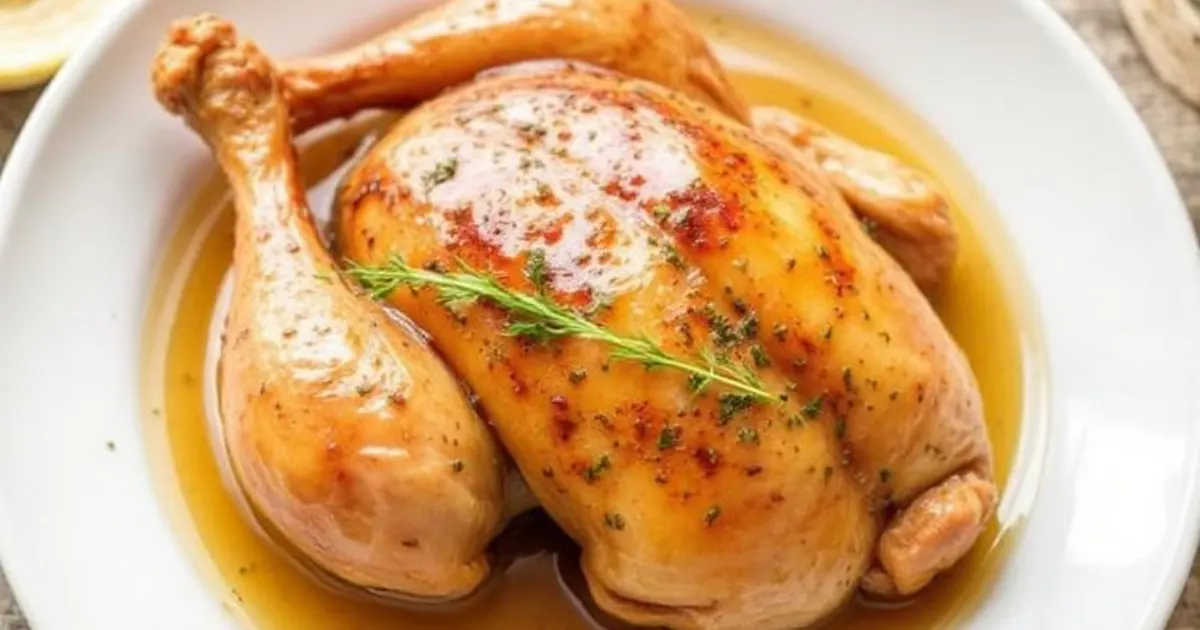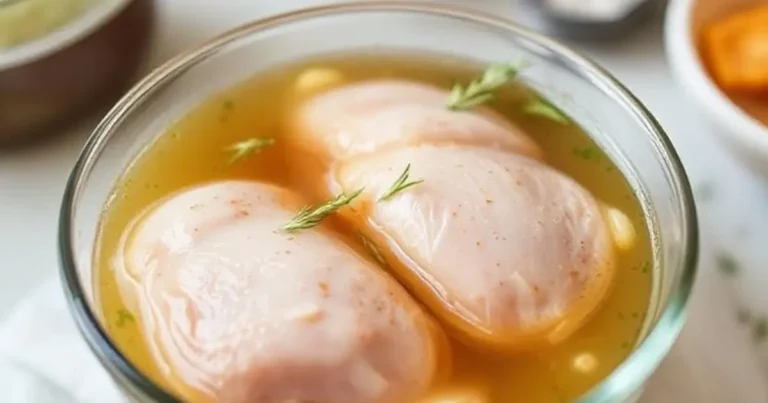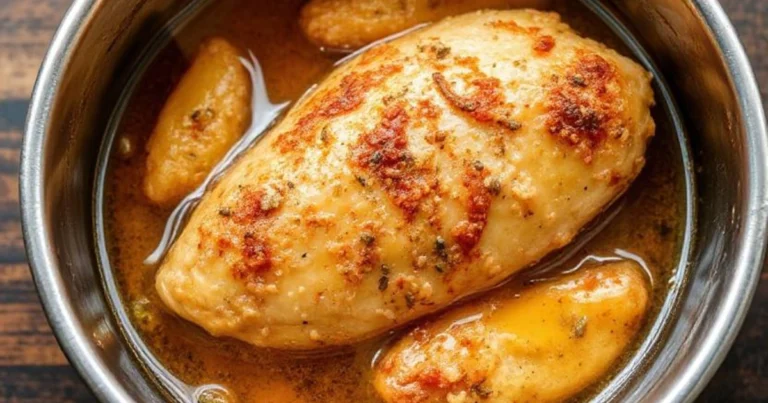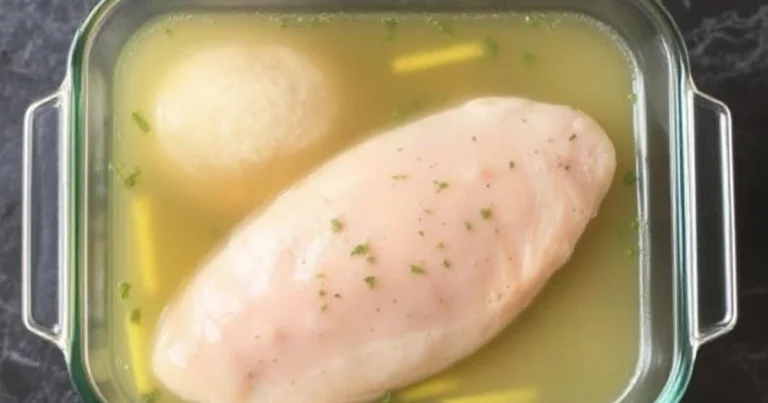Brine Chicken Recipe
Turning regular chicken into a dish fit for a restaurant starts with brining. Your brine chicken recipe can make even the simplest chicken moist and full of flavor. Both professional chefs and home cooks know that a good chicken brine is essential for tender, juicy meat that will wow your guests.
Brining is more than just a cooking method—it’s a science that keeps your chicken juicy and flavorful. Whether you’re roasting, grilling, or frying, a well-made chicken brine can greatly improve your dish.
Table of Contents
Understanding the Science Behind Chicken Brining
Chicken brine is more than just salt and water. It’s a powerful technique that makes ordinary chicken juicy and flavorful. The science behind it involves complex molecular interactions that can boost your cooking skills.
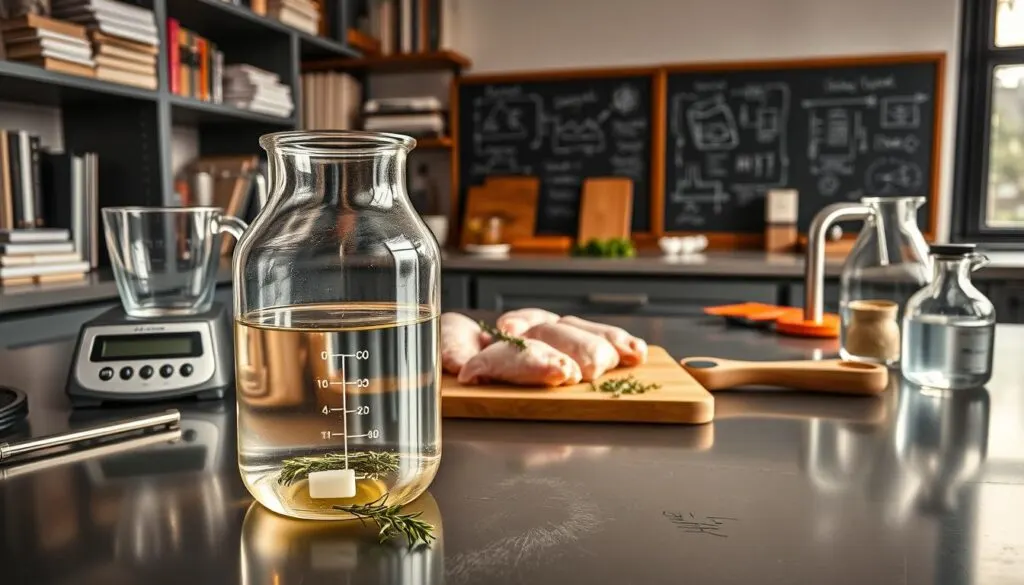
When you make a chicken brine, you start a precise scientific process. This process changes meat at a cellular level. The magic happens through several key mechanisms that impact protein structure and moisture retention.
How Salt Penetrates the Meat
Salt molecules in chicken brine work like tiny tunnels. They create pathways through protein fibers. These pathways allow:
- Deeper flavor absorption
- Increased water retention
- Protein breakdown for tenderness
The Role of Osmosis in Brining
Osmosis is key in chicken brine. As salt concentration increases, water molecules move through cell membranes. This creates a uniform moisture distribution. Your chicken stays exceptionally succulent during cooking.
Chemical Changes During the Brining Process
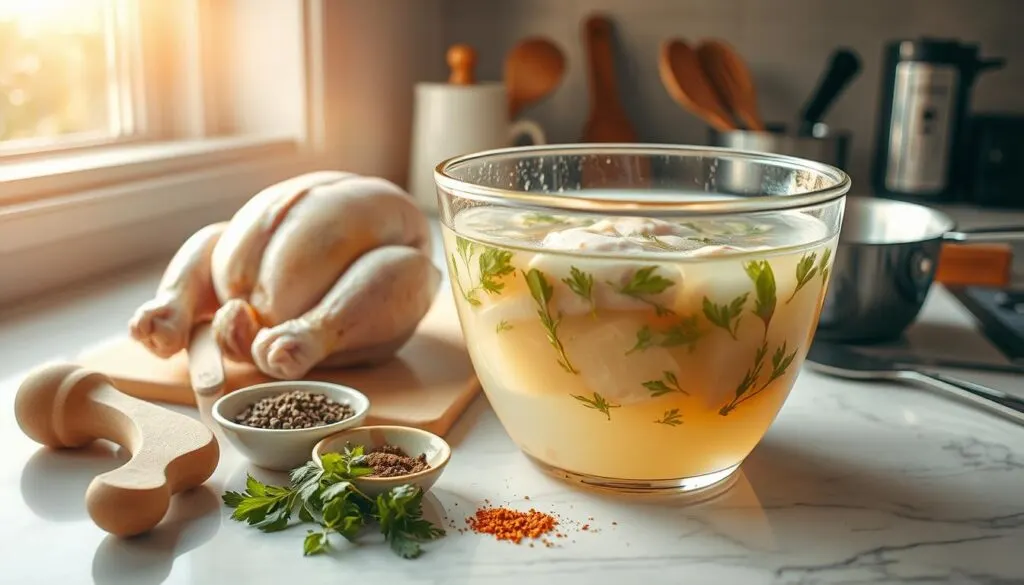
The chicken brine triggers remarkable protein transformations. Sodium chloride breaks down muscle proteins. This helps:
- Loosen muscle fibers
- Prevent moisture loss
- Enhance overall meat texture
Understanding these scientific principles will help you master the art of chicken brine. It turns every meal into a culinary masterpiece.
Essential Ingredients for a Basic Brine Chicken Recipe
Creating the perfect brine chicken recipe starts with understanding the key ingredients. These ingredients turn an ordinary piece of chicken into a juicy, flavorful masterpiece. The foundation of any great brine lies in its simple yet powerful components.
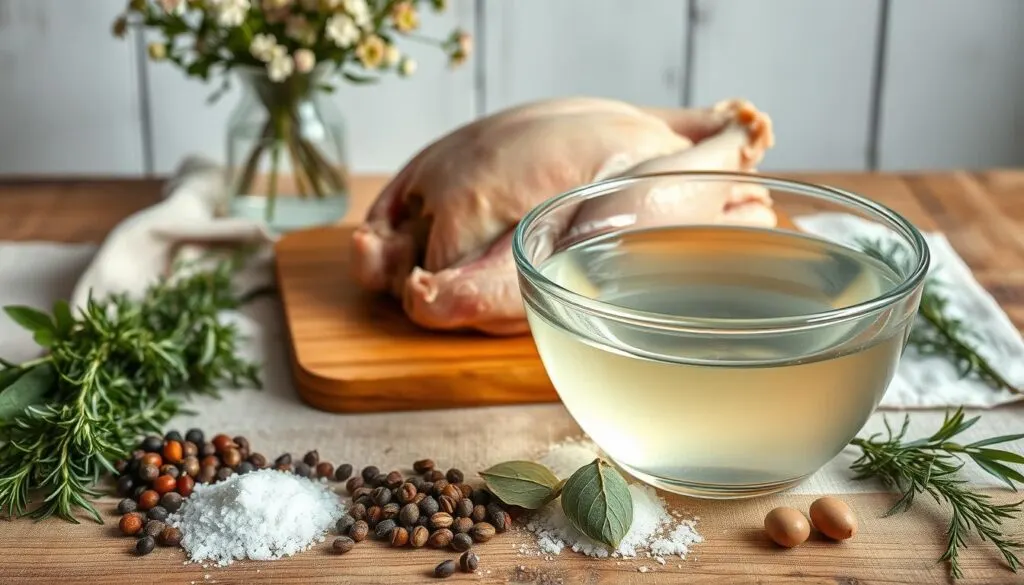
Let’s break down the essential ingredients for a basic brine chicken recipe:
- Salt: The primary ingredient that makes brining work. Kosher salt or sea salt are preferred for their pure flavor and ability to dissolve easily.
- Water: Acts as the liquid base for your brine solution
- Sugar: Helps balance the saltiness and promotes browning
Your brine chicken recipe can be customized with additional aromatics that elevate the flavor profile. Consider these optional ingredients:
- Fresh herbs (rosemary, thyme, sage)
- Whole peppercorns
- Garlic cloves
- Citrus peels
“The secret to tender, flavorful chicken is in the brine” – Professional Chef
Here’s a quick reference for ingredient proportions:
| Ingredient | Quantity for 1 Gallon of Brine | Purpose |
|---|---|---|
| Kosher Salt | 1 cup | Moisture retention |
| Brown Sugar | 1/2 cup | Flavor balance |
| Water | 1 gallon | Brine solution base |
Remember, the right combination of ingredients can transform your brine chicken recipe from good to extraordinary. Experiment with different herbs and spices to create your signature brine.
Step-by-Step Guide to Preparing Your Chicken Brine
Learning to brine chicken breast is all about precision and preparation. This process turns regular chicken into a juicy, flavorful dish. It will boost your cooking skills.
Brining chicken successfully means knowing the basics. These steps will help you make the perfect brine for your chicken.
Precise Ingredient Measurements
When brining chicken, being accurate is crucial. Here are the key measurements to follow:
- Use 1/4 cup of kosher salt per quart of water
- Add 1/4 cup of sugar for balanced flavor
- Measure ingredients using standard kitchen measuring cups
- Ensure salt and sugar dissolve completely
Temperature Control Techniques
Keeping the right temperature is key when brining chicken. Cold brine stops bacteria from growing and keeps the meat good. Remember these tips:
- Refrigerate brine immediately after mixing
- Maintain brine temperature below 40°F
- Use clean, food-safe containers
- Never leave brine at room temperature
Selecting the Right Storage Container
Choosing the right container is important for brining chicken. Look for containers that:
- Are made of non-reactive materials like glass or food-grade plastic
- Provide enough space for chicken to be fully submerged
- Have secure, tight-fitting lids
- Can fit comfortably in your refrigerator
Pro tip: Always clean and sanitize your brining container before use to prevent cross-contamination.
How to Brine Chicken Breast for Maximum Tenderness
Learning to brine chicken breast can make your cooking much better. It turns dry and bland chicken into juicy and flavorful meat. Brining is a simple way to fix tough and tasteless chicken breasts.
To start, use a basic salt water solution. The right mix of salt and water is key. A common ratio is:
- 4 cups water
- 1/4 cup kosher salt
- Optional: 2-3 tablespoons sugar
Brining helps chicken breasts stay moist while cooking. Salt breaks down protein structures, letting the meat soak up more water. This makes the chicken tender. The brining time depends on the chicken’s thickness.
For the best results, follow these steps:
- Use cold water to prevent bacterial growth
- Brine for 30 minutes to 2 hours maximum
- Rinse chicken thoroughly after brining
- Pat chicken dry before cooking
Professional chefs say to keep the chicken cold while brining for safety. Don’t let it sit at room temperature, as it can grow harmful bacteria.
Pro tip: Add herbs and spices to your brine for extra flavor infusion!
With proper brining, your chicken breasts will be moist, flavorful, and perfectly seasoned. They’ll be delicious from the inside out.
Time and Temperature Guidelines for Perfect Brining
Mastering chicken brine needs precision in time and temperature. Knowing these factors keeps your chicken juicy, flavorful, and safe. The right brining technique turns ordinary chicken into a culinary masterpiece.
Brining is a delicate process that demands careful attention. Your success depends on choosing the right brining time and keeping the temperature just right.
Brining Duration by Chicken Cut
Different chicken cuts need unique brining times for the best results. A precise approach prevents over-salting and ensures even flavor.
| Chicken Cut | Brining Time | Recommended Salt Concentration |
|---|---|---|
| Whole Chicken | 8-12 hours | 5-6% salt solution |
| Chicken Breasts | 2-4 hours | 4-5% salt solution |
| Chicken Thighs | 4-6 hours | 5% salt solution |
| Chicken Wings | 1-2 hours | 4% salt solution |
Optimal Temperature Ranges
Keeping the right temperature is key for a successful chicken brine. Always keep your brining chicken refrigerated between 34°F and 40°F to prevent bacterial growth.
- Never brine at room temperature
- Use a dedicated refrigerator space
- Monitor temperature with a reliable thermometer
Safety Considerations
Food safety is crucial when preparing chicken brine. Always use clean utensils, containers, and work surfaces. Rinse the chicken thoroughly after brining to remove excess salt and prevent over-seasoning.
Pro tip: Pat your chicken dry with paper towels before cooking to achieve a perfect golden-brown exterior.
By following these guidelines, you’ll create delicious, tender chicken every time with the perfect chicken brine technique.
Flavor Variations: Sweet, Savory, and Spicy Brines
Want to make your brine chicken recipe stand out? Try unique flavors. Each brine can change the taste and texture of your chicken. It turns a simple dish into a fun culinary journey.
Explore three exciting brine chicken recipe variations to take your cooking to the next level:
Sweet Brines: A Touch of Sweetness
- Honey-based brines add subtle sweetness
- Maple syrup creates rich, caramelized undertones
- Brown sugar brings depth and complexity
Savory Brines: Herbaceous Depth
Make a robust brine chicken recipe with these savory ingredients:
| Herb | Flavor Profile | Best Paired With |
|---|---|---|
| Rosemary | Earthy, pine-like | Roasted chicken |
| Thyme | Subtle, minty | Grilled chicken |
| Garlic | Intense, pungent | Pan-fried chicken |
Spicy Brines: Kick Up the Heat
For those who enjoy spicy, try these:
- Jalapeño peppers for mild heat
- Habanero sauce for intense spiciness
- Chipotle peppers for smoky warmth
The secret to a great brine chicken recipe is finding the right balance. Don’t overpower the chicken’s natural taste. Start with small amounts and adjust to taste.
Preparing Smoked Chicken Brine for Enhanced Flavor
Making the perfect smoked chicken brine turns a simple meal into a feast. The right mix of ingredients and smoking methods boosts your chicken’s taste. It takes it to new levels.
To make a tasty smoked chicken brine, you need to think about a few important things. You want to add deep, rich flavors to the meat. You also want it to stay moist and tender.
Selecting the Right Wood for Smoking
Choosing the right wood is key for a great smoked chicken brine. Each type of wood gives a different flavor:
- Hickory: Provides a strong, bacon-like intensity
- Apple wood: Offers a sweet, mild flavor
- Pecan: Delivers a rich, nutty undertone
- Cherry wood: Adds a subtle fruity essence
Mastering Temperature Control
Keeping the temperature just right is crucial when smoking chicken. Your smoker should stay between 225-250°F. This ensures the chicken cooks evenly and absorbs flavors well.
Timing Your Smoking Process
How long you smoke the chicken depends on its size and cut. Generally, it takes about 45-60 minutes per pound. This makes sure the chicken reaches a safe internal temperature of 165°F.
Pro tip: Use a meat thermometer to check the chicken’s temperature. This helps avoid overcooking your brined chicken.
Creating the Perfect Fried Chicken Brine
Making the perfect fried chicken brine turns regular chicken into a crispy, juicy delight. The secret is a well-made brine that keeps the chicken moist and flavorful.
Your brine should do two main things: keep the meat tender and add tasty seasonings. The right brine acts as a shield, stopping the chicken from drying out when it’s fried.
- Use kosher salt as the primary brining ingredient
- Select complementary herbs and spices
- Maintain proper salt-to-water ratio
- Brine for the optimal time (typically 4-12 hours)
A classic fried chicken brine includes:
- Water – as the base liquid
- Kosher salt – for flavor penetration
- Sugar – to balance saltiness
- Aromatics – like garlic, paprika, or black pepper
After brining, dry your chicken well. This step is key for that crispy, golden-brown outside everyone loves. The brine makes sure each bite is full of flavor and moisture.
Pro tip: Always refrigerate your chicken while brining to maintain food safety and prevent bacterial growth.
Common Brining Mistakes to Avoid
Mastering chicken brine needs precision and understanding. Even skilled home cooks can make mistakes that ruin their chicken. Knowing these common errors will help you make perfectly seasoned, juicy chicken every time.
Preventing Over-Brining Disasters
Over-brining can make your chicken too salty and mushy. Timing is key. Different chicken cuts need different brining times:
- Chicken breasts: 30-60 minutes
- Whole chickens: 8-12 hours
- Chicken thighs: 2-4 hours
Salt Concentration Challenges
Getting the salt ratio wrong in your chicken brine can lead to disappointing results. A standard brine typically uses:
- 4-6% salt solution (about 1 cup of salt per gallon of water)
- Kosher salt works best for even distribution
- Avoid table salt, which can create uneven seasoning
Temperature Management Problems
Proper temperature control is crucial when preparing chicken brine. Always refrigerate your brining chicken between 34-40°F to prevent bacterial growth. Never leave chicken brine at room temperature for extended periods.
Pro tip: Use a digital thermometer to ensure consistent brining temperatures and food safety.
Tips for Cooking Your Brined Chicken
Turning your brine chicken into a tasty meal needs careful cooking. After brining, your chicken is full of moisture and flavor. This makes cooking very important to keep those qualities.
There are different ways to cook your brined chicken. Here are some key tips for great results:
- Pat the chicken dry before cooking to ensure crispy skin
- Reduce cooking temperature by 25 degrees compared to unbrined chicken
- Use a meat thermometer to check internal temperature
- Allow the chicken to rest for 10-15 minutes after cooking
Roasting is a great way to cook brined chicken. Preheat your oven to 375°F and put the chicken on a rack. Cooking times will vary depending on the cut, but usually take 45-60 minutes for a whole chicken.
Grilling is another excellent choice for your brine chicken. Keep the heat medium and use indirect cooking to avoid burning. The brined meat stays juicy and tender, with amazing flavor.
Pan-frying is good for smaller cuts like chicken breasts. Use a cast-iron skillet for even heat. This way, you get a golden-brown outside and a moist inside.
Pro tip: Always let your brined chicken come to room temperature before cooking for the most even results.
Remember, brined chicken cooks a bit faster than unbrined. Keep an eye on it to avoid overcooking. This way, you’ll keep the chicken tender and full of flavor from brining.
Conclusion
Your journey into brine chicken recipes has given you powerful tools. These tools help turn regular chicken into amazing dishes. You now know how to make chicken juicy and full of flavor.
Success in brine chicken recipes comes from trying new things and paying attention to details. Whether you’re making smoked, fried, or roasted chicken, brining is key. Each method you’ve learned lets you tailor your cooking to your taste and needs.
Keep working on your brining skills, and remember, precision is important. Focus on salt levels, brining times, and keeping the right temperature. Begin with simple recipes and then try new spices, herbs, and liquids to match your cooking style.
We encourage you to share your brining stories and recipes. Your experiences can help others see the magic of brine chicken recipes. Start trying new things, trust your taste, and enjoy the tasty results of your hard work.
FAQ
How long should I brine chicken?
The brining time varies by chicken cut. For breasts, brine for 30 minutes to 2 hours. Whole chickens need 8-12 hours. Never brine for more than 24 hours to avoid too much salt and texture changes.
What is the basic ratio for a chicken brine?
Use 1 cup of kosher salt per gallon of water for a basic brine. Add 1/4 cup of sugar and herbs or spices for flavor. Make sure the salt dissolves fully before adding the chicken.
Can I brine frozen chicken?
No, thaw chicken before brining. It needs to be at a safe temperature and absorb the brine well. Thaw it in the fridge before brining.
Is brining safe for all cooking methods?
Yes, brined chicken works for roasting, grilling, smoking, and frying. It may cook faster because of the moisture. Adjust cooking time and temperature as needed.
What type of salt should I use for brining?
Use kosher salt for brining. Avoid iodized table salt, as it tastes metallic and doesn’t dissolve well. If using table salt, use half the amount because it’s denser.
Can I reuse a chicken brine?
No, never reuse a brine after it’s had raw chicken. Discard the brine and make a fresh batch for each use.
How do I prevent my brined chicken from being too salty?
Follow the brining time carefully to avoid over-salting. Rinse the chicken under cold water and dry it with paper towels. You can also use less salt or brine for a shorter time.
Can I brine chicken for fried chicken?
Yes! Brining makes fried chicken moist and tender with a crispy exterior. Rinse and dry the chicken before dredging and frying for the best coating.
What additional flavors can I add to my chicken brine?
Add garlic, bay leaves, peppercorns, herbs, citrus zest, or apple cider to your brine. For sweetness, use honey, maple syrup, or brown sugar. Try different combinations to find your favorite.
Do I need to refrigerate chicken while brining?
Yes, brine chicken in the fridge to keep it safe and prevent bacterial growth. Keep it fully submerged and at 40°F or below.

